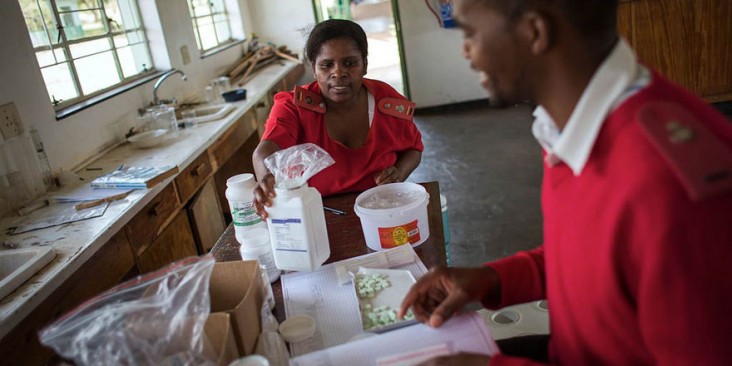- What We Do
- Agriculture and Food Security
- Democracy, Human Rights and Governance
- Economic Growth and Trade
- Education
- Environment and Global Climate Change
- Gender Equality and Women's Empowerment
- Global Health
- Humanitarian Assistance
- Transformation at USAID
- Water and Sanitation
- Working in Crises and Conflict
- U.S. Global Development Lab
Speeches Shim

The U.S. Agency for International Development (USAID) announced the release of results of a University of Liverpool-led trial that demonstrates nanoformulations' ability to transform HIV treatment by reducing by half the dose of leading antiretroviral therapies (ART). Nanoformulations involve the understanding, design, engineering and fabrication of materials at the atomic and molecular level in order to decrease size and improve effectiveness. The trial findings were presented at the Conference on Retroviruses and Opportunistic Infections (CROI) in Seattle, an annual gathering of the top scientists from around the world sharing the latest developments in HIV and AIDS and related infectious disease research.
The first-in-human trial results confirmed the potential for a 50 percent dose reduction while maintaining the same measure of effectiveness as when it was originally developed. The novel nano approach was shown to have the same disease-fighting impact for two critical HIV drugs: efavirenz (EFV) and lopinavir (LPV). EFV is part of the current World Health Organization (WHO)-recommended, preferred first-line HIV treatment regimen. Reports show 70 percent of adult patients are taking an EFV-based HIV treatment regimen in the low- and middle-income countries hardest hit by the HIV epidemic.
The development of lower-dose HIV treatment regimens has significant real-world benefits for patients and healthcare systems. Lower doses help improve drug absorption into the body, reduce manufacturing costs and transform multi-pill regimens into single tablets that can increase patients' adherence. Such reductions in cost and improvements in patient outcomes are critical to implementing the WHO's recommendations to "Treat All" people living with HIV and to achieve the global 90-90-90 targets.
The trial was conducted by the collaborative nanomedicine research program led by Pharmacologist Professor Andrew Owen and Materials Chemist Professor Steve Rannard in collaboration with the St. Stephen's AIDS Trust at the Chelsea & Westminster Hospital in London. This innovative collaboration engages leaders in the global efforts to incorporate nanotechnology – the manipulation of matter on an atomic, molecular and supramolecular scale – into nanomedicine, the application of nanotechnology to the prevention and treatment of disease in the human body.
The trial is part of the University's ongoing work as part of the multinational consortium OPTIMIZE, a global partnership working to accelerate access to simpler, safer and more affordable HIV treatment. Funded by USAID and the U.S. President's Emergency Plan for AIDS Relief (PEPFAR), OPTIMIZE is led by the Wits Reproductive Health & HIV Institute in Johannesburg, South Africa, and includes the interdisciplinary Liverpool team, Columbia University, Mylan Laboratories and the Medicines Patent Pool. OPTIMIZE is supported by key partners including UNITAID and the South African Medical Research Council.
To bring nanoformulations' potential from the laboratory to patients, OPTIMIZE is supporting clinical trials to fill the data gaps required to bring lower-dose combinations into global and national guidelines. These efforts will help demonstrate whether lower-dose EFV (EFV 400mg) is equivalent to the current first-line dosing (EFV 600mg). If successful, the combination of these clinical trial and nanoformulation efforts could lay the groundwork for an even smaller EFV dose (200mg), resulting in significant cost savings by improving patient outcomes and freeing up manufacturing capacity.
"The potential applications for HIV treatment are incredibly promising. By aligning efforts, these integrated investments offer the potential to reduce the doses required to control the HIV virus even further, resulting in real benefits globally. This would enable the costs of therapy to be reduced which is particularly beneficial for resource-limited countries where the burden of disease is highest," said Benny Kottiri, USAID's Office of HIV/AIDS Research Division Chief.
Further application of the nanoformulation technology through OPTIMIZE is also leading the way in advancing options for patients who fail first-line therapy. This is becoming a pressing need as the expansion of treatment increases the number of patients requiring more expensive and complicated first-line alternatives. OPTIMIZE supports an integrated portfolio of clinical trials and nanoformulation activities to assess possible second-line alternatives. As with EFV, these efforts could hold the potential to further halve lower-dose alternatives demonstrated to be as effective as the current dose in clinical trials. Second-line treatment currently requires multiple pills and additional drugs called "boosters," which add expense and manufacturing complications. Ultimately, these nanoformulation efforts will be critical to providing patients with cost-effective, once-a-day, single pill alternatives.
USAID, through PEPFAR, is proud to support OPTIMIZE, a global partnership unifying distinct voices to achieve a common goal: accelerating access to simpler, safer and more affordable HIV treatment. Learn more about OPTIMIZE.

Comment
Make a general inquiry or suggest an improvement.